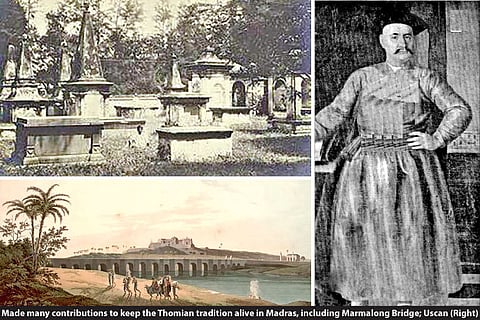

Chennai
In the 16th Century, Armenia, a landlocked country in the South Caucasus region of Eurasia, had ceased to exist as a nation with the Ottoman Empire and the Safavid dynasty of Iran annexing half each of it. An enslaved county offered little scope for enterprising people and this had scattered the mercantile Armenian community, thus creating an Armenian diaspora throughout the world.
The headquarters of the Armenian merchants was new Julfa in Persia. With capital provided by his wealthy grandfather, young Coja Petrus Uscan, who hailed from the formidable Veligianian family, had left Persia to set up a business in the Philippines, where Manila was a polyglot trading centre and served as a base for American silver to enter Asia (silver was in great demand as the Chinese would trade only for that).
The Armenians were very crucial to the East India Company and were treated well. The Armenians, who formed the economic core of the Manila’s commerce, even financed the company several times. The East India Company also made use of another of the Armenian service – the courier network. The East India Company would dispatch the goods by ship via Cape of Good Hope around Africa, but would send a copy of the list of goods to London headquarters by land by the faster Armenian network. The headquarters at London would have a month’s time before the ship arrived to trade and place the goods for maximum profit. The Armenian community of Madras gained prominence in the 17th century AD and exercised a significant amount of power and domination when Uscan translocated from Manila. He who led the Armenian community of Madras from 1723 to 1751 and is regarded as the pillar of the community in the nascent city. As his gravestone in a Vepery church indicates, he was an intercessor in disputes the company had with powers much stronger than them.
In 1740, when Marathas invaded the Carnatic, Petrus Uscan was appointed the British envoy to negotiate peace with an invader. Uscan’s diplomacy may have saved the city of Madras from being crushed and as a reward, he was appointed Company Councillor for the British East India Company.
When the French captured Madras after a prolonged bombing in 1746, they seized Petrus Uscan’s belongings and carried them off to Pondicherry. Dupleix, the French governor-general, offered him protection and restoration of the confiscated property if Uscan shifted his loyalty to the French. But Uscan was too loyal to the British and moved to a Danish ship anchored off the Madras shore and stayed there for months rather than live in a town where the French flag flew. When Madras reverted to British control in 1749, Petrus Uscan and one Mrs Madeiros were the only Catholics permitted to reside in the Fort.
Influenced by Catholicism and St Thomas traditions in Manila itself (the University of Santo Tomas had been established there in 1611), Uscan made many contributions to keep the Thomian tradition alive in the Madras city. When the grave of St Thomas was opened for public viewing in Santhome, Uscan was among those present.
In 1726, he constructed the steps which led to the Catholic shrine atop St Thomas Mount, which still bears a slab commemorating Uscan’s legacy.
In 1728, to provide a safe passage across the Adyar River for pilgrims to St Thomas Mount, Uscan constructed the Marmalong (Mambalam) Bridge across the Adyar River costing 30,000 pagodas. A typical businessman, he also donated 1,500 pagodas for the bridge’s upkeep. On a very graceful plaque set on this bridge, the merchant inscribed in three languages (Armenian, Persian, Latin): “This bridge was built for public interest by Coja Petrus Uscan, belonging to the Armenian nation, AD 1726.” The bridge and step access to the hill were the triggers to forming the road which later evolved into the Mount Road and fuelled the southern expansion of the city.
Petrus Uscan donated lavishly for Christian religious endowments. He was one of the foremost contributors to the construction of St Rita’s Church in Santhome. A slab on the east wall of the church has the inscription “In the memory of the Armenian nation, 1729.” This is perhaps the only church in the world dedicated to the memory of a nation.
Petrus Uscan died in 1751 and was buried in the Chapel of Our Lady of Miracles, which he owned. Though it is now an Anglican church, Petrus Uscan’s tombstone was however left untouched and it remains to this day. His tombstone in Vepery reads “…one who spent his money lavishly and without stint to promote the worship of God and sacred buildings, Petrus Uscan, an Armenian whose heart is at Julfa.”
Uscan’s will of 200 pages, executed by the laws of Madras, reveals how the cultural and social aspects which were prevalent in Madras of the yore as well as global Armenian trade at that time. He was worth 96,000 pagodas and the amount was to be distributed according to covenants in his will.
The will also contains a very unique request to his executors: to have his heart surgically removed from his body and transported in a golden box for special burial in his home town of Julfa. Was the transfer really done nobody knows for sure though a portrait of Uscan hangs in the church in Julfa.
—The author is a historian
Visit news.dtnext.in to explore our interactive epaper!
Download the DT Next app for more exciting features!
Click here for iOS
Click here for Android